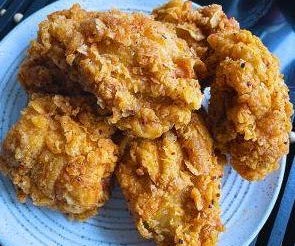Introduction: Green Thai Chicken Curry
This is one of the most tasty and flavoursome curries I've ever made.
The curry has an amazingly fresh taste, with creamy coconut, just enough chilli and loads of coriander.
The original recipe excluded the vegetables, but to fill a house full of students I added vegetables I thought would complement it to help fill us up and make it cheaper. If you don't fancy green beans, mange tout go really well as well.
The recipe for the curry paste I use can be found here, it's really quick to make in batches in a food processor and can be frozen up to 6 months for convenience.
The curry has an amazingly fresh taste, with creamy coconut, just enough chilli and loads of coriander.
The original recipe excluded the vegetables, but to fill a house full of students I added vegetables I thought would complement it to help fill us up and make it cheaper. If you don't fancy green beans, mange tout go really well as well.
The recipe for the curry paste I use can be found here, it's really quick to make in batches in a food processor and can be frozen up to 6 months for convenience.
Step 1: Ingredients
- 2 tbsp
green thai curry paste (according to taste) - 1 tbsp soft dark brown sugar
- 2-3 large carrots, cut into thin sticks
- 200g fine green beens, cut into ~4cm lengths
- 1-2 thick stalks lemongrass, fat ends bashed with a rolling pin (optional), I use paste
- 750g/1½lb skinless, boneless chicken, cut into chunks (use breast and/or leg meat)
- zest and juice of one lime
- 400ml/14fl oz coconut milk (a can full)
- 2 tbsp Thai fish sauce (or light soy sauce)
- handful of coriander, roughly chopped (the more the better though to be honest)
Step 2: Fry the Chicken in the Paste
Add the paste to a large pan. If frozen, heat until it melts.
Heat the paste until it starts to fry, allow it to do so for a few minutes then throw in the chicken.
Fry the chicken in the paste on a medium heat for 5 minutes.
Heat the paste until it starts to fry, allow it to do so for a few minutes then throw in the chicken.
Fry the chicken in the paste on a medium heat for 5 minutes.
Step 3: Add the Veg
Lop the ends of the beans and carrots. Cut the beans in half and chop the carrots into thin sticks.
Add the soft brown sugar to the pan. Drop in the vegetables and fry with the chicken for a further 5 minutes on a medium heat. This helps them soak up the flavours from the paste.
If you like your curries hot, now would be a good time to add an extra chilli. The chillies in the paste are usually plenty for me though, I think this curry is more about the flavours than the heat.
Add the soft brown sugar to the pan. Drop in the vegetables and fry with the chicken for a further 5 minutes on a medium heat. This helps them soak up the flavours from the paste.
If you like your curries hot, now would be a good time to add an extra chilli. The chillies in the paste are usually plenty for me though, I think this curry is more about the flavours than the heat.
Step 4: In With the Rest
Finally, add the fish sauce, lemongrass, lime, coconut milk and coriander.
Allow to simmer gently until the carrots and beans are cooked to your liking.
Serve with rice.
Yum!
Allow to simmer gently until the carrots and beans are cooked to your liking.
Serve with rice.
Yum!











